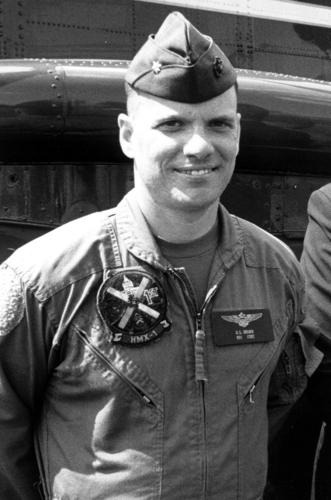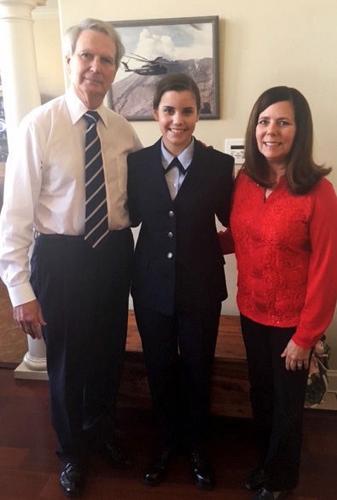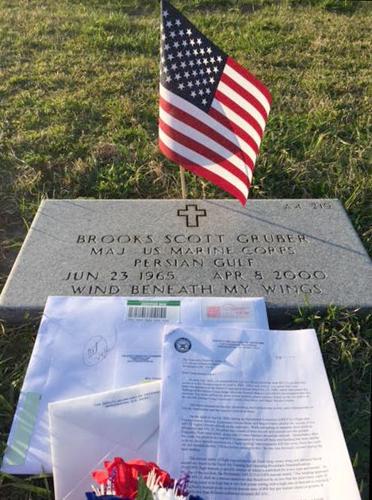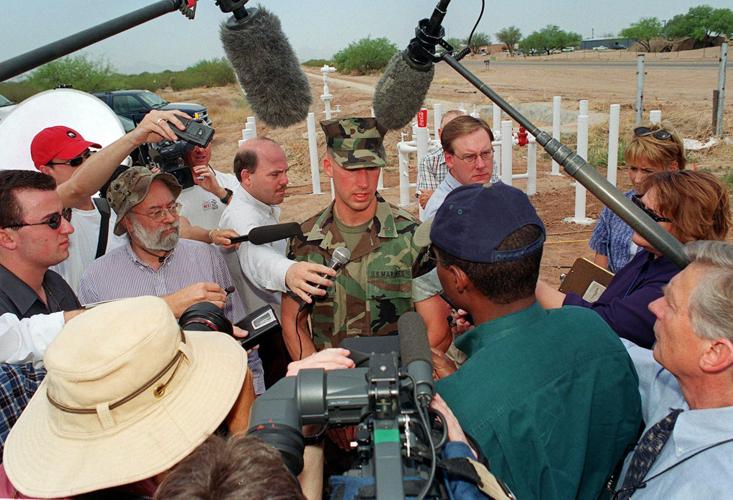The tradition is always the same.
Every April 8, Connie Gruber visits her husband’s grave.
She and daughter Brooke kneel in front of his tombstone in Jacksonville, North Carolina. Together, they run their fingers over each letter in his name, saying out loud “Brooks Scott Gruber.”
Connie carries with her two things: flowers and a constant ache in her heart. This year, though, she brought with her something she hasn’t had since he died in an aircraft crash in the Marana desert — peace.
It was bad enough to lose her soulmate, but in the accident’s aftermath a Marine Corps news release blamed her husband and Lt. Col. John Brow for the Osprey accident that killed 19.
It’s taken 16 years, but Connie — ever the faithful Marine Corps wife who supported her pilot husband’s many far-flung assignments — has finally accomplished her own mission to clear his name.
Couple had a lot to celebrate
Brooks and Connie married in 1992, after meeting on a blind date two years earlier. He was a helicopter pilot, a first lieutenant, a month away from being deployed for the Gulf War. She was a teacher at Marine Corps Base Camp Lejeune in Jacksonville.
“I liked him immediately,” Connie said in a phone interview from her home in Jacksonville. Connie is an instructor and supervisor of elementary education students at the University of North Carolina Wilmington.
“You hear the expression ‘I’ve known him all my life,’ he was just that friendly and easy to talk to.”
The Grubers had a lot to celebrate as they rang in 2000. They delighted in every milestone of their child, who’d arrived in July. Connie had completed her doctorate in education and landed a new teaching job. The young family had settled into their new home in Jacksonville, and Brooks was excited about his elite assignment to be one of the first to fly the Osprey, a hybrid aircraft that can take off and land like a helicopter and fly horizontally like a fixed-wing plane.
“He believed in the Osprey, he believed in its mission,” Connie recalled. “He said to me that it’s going to save lives.”
Because the baby was so young and Brooks was only scheduled to be stationed in Yuma until April or May, the Grubers decided Brooks would go alone. He left on Valentine’s Day.
Testing a new aircraft
Brow and Jim Schafer were also part of that pioneering squad deployed to Yuma for operational testing of the V-22 Osprey.
“The Marine Corps is a band of brothers,” Schafer, a retired Marine lieutenant colonel, said in a phone interview from Reedville, Virginia.
This crew was tight.
“We’re testing aircraft, we’re doing some weird things,” he said. “The closeness gets even more.”
Schafer recalled how Brooks, a standout athlete who attended Virginia Military Institute, drove to Virginia to give Schafer’s son his own personal two-day hockey camp. Schafer fished with Brow and his two boys.
Brooks’ call sign was Chucky after the doll in the “Child’s Play” horror movies, not because Brooks would ever be mistaken for a crazed kid’s toy but because he had that same, no-holds-barred enthusiasm.
“That man was always ready to run through a brick wall,” said Schafer, whose own call sign is Trigger. “He was full of energy.”
Brow was known as Boot. Schafer nicknamed him “the Booterometer,” because he was honest and level-headed. “He was like our sanity board.”
The night of April 8, the Osprey crew had left the Marine Corps Air Station in Yuma to run through a nighttime simulated rescue operation in Marana.
Boot, 39, was the pilot and Chucky, 34, the co-pilot of Nighthawk 72, which flew behind the lead Osprey. Schafer was part of the second wave of the exercise and estimates he was 5 minutes behind them. He couldn’t believe it when he looked down and saw flames shooting up into the black sky. All aboard Nighthawk 72 died.
Painful path to the truth
At Brooks’ memorial service, the song “Wind Beneath My Wings” played as a slideshow flashed moments from his life. The oldest of three boys, Brooks was known for his confidence and huge, infectious grin.
North Carolina Republican Congressman Walter Jones sat behind Connie, who cuddled baby Brooke on her lap. The longtime legislator’s district includes Camp Lejeune and he’d just joined the House Armed Services Committee. Though he didn’t know the Grubers, he wanted to pay his respects. Two years later, he became Connie’s fiercest ally.
The grieving widow couldn’t believe the pain of losing Brooks could get any worse. Then the Marine Corps issued a press release three months after the accident that further pierced her heart. It highlighted a combination of “human factors” that led to the crash and bluntly stated: “Unfortunately, the pilots’ drive to accomplish that mission appears to have been the fatal factor.”
From then on, media accounts of the incident — the pilots lost control of the aircraft while trying to maintain position behind the lead Osprey and crashed — simply cited pilot error.
“It compounded our pain and delayed the healing process greatly, tremendously,” Connie said. “I felt that he died in the desert in Marana and then he died again in the press. He continued to be sacrificed.”
Starting with the leaders at Marine Corps Air Station New River, where Brooks worked, Connie began calling and knocking on doors. She wrote to the Pentagon.
“I got a response that reassured me that my husband and John Brow were excellent pilots and were handpicked to fly the Osprey,” she recalled. “I appreciated that and I believed every word of that, but what I really needed was an answer about the press release and what it had done to their reputations and what it had done to their place in military aviation history. As pioneering pilots, they had done everything they were taught.”
After two years and no headway, she began working on members of the House Armed Services Committee. One of her letters arrived for Jones. It was obvious he wasn’t the first or only one to receive such a missive — the letter was typed yet his name was handwritten in — but it spoke directly to him.
“Basically, it said, ‘If you are a man of integrity, please help me clear my husband’s name,’” Jones said in a phone interview. “I just could not get it out of my mind. It was such a heart-wrenching letter, the unfairness of him and John Brow being blamed.”
‘They were set up’
Jones took up the cause on behalf of Connie and Brow’s widow, Trish. To say it was an uphill battle is an understatement. Former secretary of defense-turned-vice president Dick Cheney had long been against the Osprey program.
“There was so much pressure on the Marine Corps on saving the V-22,” Jones said.
The Marine Corps, he said, wouldn’t even look at the research they’d accumulated. “We had to fight them tooth and nail.”
Schafer — who said he nearly “bit it” the week before the fateful crash — says corners were cut and pilot training inadequate, and his buddies took the fall.
“Marines don’t leave their dead on the battlefield,” he said. “We pride ourselves on that. We left Boot and Chucky on the battlefield. … They were set up. You took the very best pilots in the Marine Corps and you overloaded them.”
In the years since the 2000 crash, lawsuits were settled, Marine Corps officials were charged with misconduct for falsifying Osprey maintenance records. Marines died in other Osprey accidents.
Still, it took until the summer of 2015 before Jones found someone who would listen: Deputy Secretary of Defense Robert O. Work, a former Marine who had been confirmed to his post the year before. Work penned the letter that the pilots’ families had wanted for so long.
In its six pages, Work points out that a string of events led to the accident and that there were deficiencies in the V-22’s development and engineering as well as safety programs that were only corrected after the crash. While Work says Brow and Brooks made decisions that contributed to the accident, he disputes that they were solely responsible.
“The totality of evidence confirms the adage that every accident is the result of an interrelated chain of events; if any link in the chain is broken, the accident never occurs. And after considering all of the links in the chain of events that led to this particular accident, I disagree with the characterization that the pilots’ drive to accomplish the mission was ‘the fatal factor’ in the crash.”
Jones hand-delivered the letter to Connie and Brooke the afternoon of Feb. 17. They laid a copy at Brooks’ grave.
“We just focused on the justice of it, really, the justice in all the words,” Connie said. “As hard as the truth is and as hard as it hurts, it was accurate. We’re grateful to have the truth out there, the full truth.”
The importance
of integrity
Brooks Gruber’s name graces a Jacksonville bridge. It’s also etched on a stone marker outside Marana Northwest Regional Airport and on a polished black granite memorial honoring Marine air crewmen killed in Osprey crashes at Semper Fidelis Memorial Park in Triangle, Virginia.
His real legacy, though, is his namesake — daughter Brooke, who’s in the Air Force Junior ROTC at her high school and who turned 16 this past summer.
The birthday banner is still up at the home where she and her mother live.
“We say this is the best Sweet 16 gift — taking back that honor of her father,” Connie said.
She refuses to focus on how long it took to exonerate her husband, but instead on how the journey has made her and Brooke better people. In death, her husband taught their daughter the importance of integrity.
“She knows that in this life you stand up for the truth,” Connie said. “Even though he’s not here to teach her that physically, I think part of this battle, what has been good about it, is the lesson our daughter has learned. Also, about the Marine Corps values — honor, courage, commitment. I just feel like this journey has demonstrated those values. It’s also a demonstration of the true meaning of ‘semper fi,’ which is ‘always faithful.’ ”











